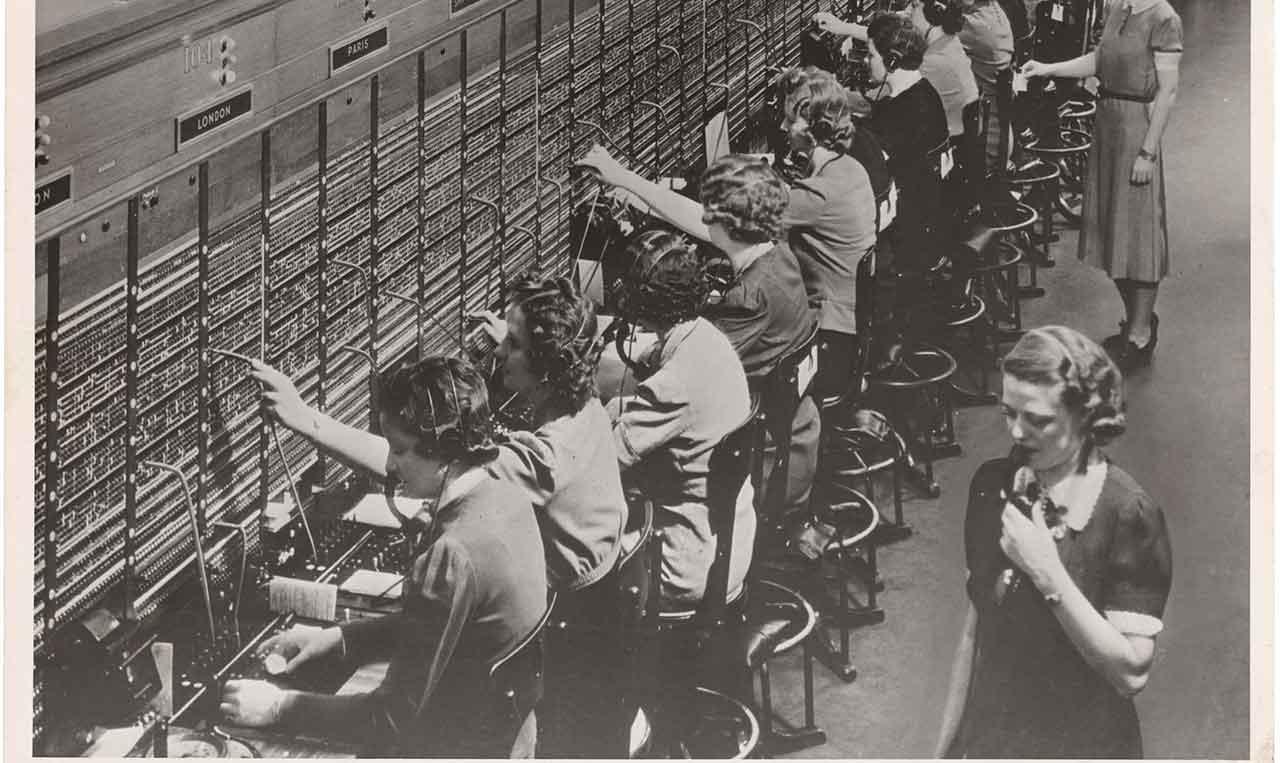The telephone and phone systems throughout history
Key Points
•Learn the most important dates in the history of telephones.
•Find out more about Alexander Graham Bell.
•Explore the history of the telegraph and morse code.

The telegraph was a great leap forward in the history of communication, allowing people to communicate over long distances. However, a telegraph line could only reliably transmit one message at a time, and sending messages required the people at both ends of the line to know Morse code. Inventor Alexander Graham Bell figured out that more than one pitch could travel on the same wire at the same time, meaning that multiple sounds could be sent at once. He worked on the device with a young electrician named Thomas Watson, aiming to make such a multiple-message telegraph. But as they worked, a new goal evolved: They realized that the sounds of human speech could be used to change the strength of an electric current, and these variations in current strength could be decoded as audible sounds at the other end of the line. The result was the invention of the telephone. In March of 1876, at just 29 years old, Bell made the first telephone call.
The telephone: important dates
• 1874: Alexander Graham Bell figures out the basics of how a telephone should be able to work.
• 1876: Bell receives a patent for the first telephone.
• 1877: Bell founds Bell Telephone and travels across the country promoting his invention.
• 1878: Queen Victoria receives Bell on the Isle of Wight, where Bell explains and demonstrates the telephone.
• 1880s: Telephone systems expand, enabling long-distance calling.
• 1888: The U.S. Supreme Court upholds Bell’s telephone patent rights, which ends a series of legal proceedings related to the issue.
• 1889: William Gray invents the pay phone, installing the first outside of a bank in Hartford, Connecticut.
• 1891: Almon Strowger, an undertaker in Kansas City, invents the first automatic telephone switching system to keep operators from misdirecting his customers to the wrong number.
• 1918: The telephone helps people communicate during the Spanish Flu epidemic.
• 1921: Telephone lines are used to broadcast the speeches and music from the first burial at the Tomb of the Unknown Soldier at Arlington National Cemetery in Virginia to an estimated crowd of 60,000 people gathered in New York City and 20,000 in San Francisco.
• 1927: The first transatlantic phone calls are made between London and New York.
• 1947: Bell Laboratories, part of AT&T, begins research into what would become the modern-day cellular phone network.
• 1947: Three scientists at Bell Laboratories demonstrate their transistor, revolutionizing the world of telephony.
• 1962: A cordless phone is introduced at the Seattle World’s Fair.
• 1983: MCI begins the telecom race to use fiber-optic lines for communication.
• 1994: IBM unveils Simon, the first touchscreen smartphone.
• 1995: VoIP (Voice over Internet Protocol) allows people to make phone calls over the internet.
• 2007: The iPhone is announced, ushering in the smartphone era.
Alexander Graham Bell
Bell was a Scottish inventor and scientist who was born in 1847. He’s mostly known for the invention of the telephone, which transformed long-distance communication around the world. Born in Edinburgh, Bell had a strong interest in sound and speech early on in life, motivated by the fact that his mother lost her hearing as he was growing up. In the 1870s, he worked hard to improve the telegraph system, and his experiments led to the design of the telephone, a device that could convey sound over electric wires. Bell and his family moved to Canada in 1870 and then settled in the United States in 1871. On March 10, 1876, the inventor made the first ever telephone call. Shortly thereafter, he established his own business and began traveling to demonstrate his invention, which quickly caught on, connecting people and businesses like never before.
• The Birth and Legacy of Alexander Graham Bell
• Everything to Know About Alexander Graham Bell
• Alexander Graham Bell: Transforming Communication
The telegraph and morse code
The invention of the telephone depended on the earlier invention of the telegraph. While people had been devising different means of communicating across distances for centuries, not until 1837 could they send a message almost instantly from one person to another. That’s when William Fothergill Cook and Charles Wheatstone in England created the first version of the telegraph with 20 letters. Samuel Morse in the United States later invented a different version of the telegraph, along with a coded alphabet and numbers that could be used to transmit messages. His device worked by transmitting electrical signals over a piece of wire laid between two places. By tapping a combination of long pulses, short pulses and pauses, messages could be sent in mere moments.
Additional information on telephone history
• Invention of the Telephone: Discover how the telephone was invented, including Bell’s many contributions.
• How Morse Code Works: This resource explains how Morse code turns “dots” and “dashes” into letters and numbers.
• The Telephone Network: Dig into the technical details of how a telephone network works in this document.
• The Princess Telephone: This popular model of telephone was invented in 1959.
• How the Telephone Changed Society: The telephone had a huge impact on society as both an instrument of business and a means of socializing.
• From the Early Telephone to the iPhone: Connecting to anyone in the world through a telephone wire was once revolutionary, but now, it’s becoming passé, replaced by wireless technologies. However, none of today’s devices would be able to work without the wires that still crisscross the world, connecting servers and networks.
• Photos: A visual history of the telephone: Explore the progression of the telephone through this photographic timeline.



